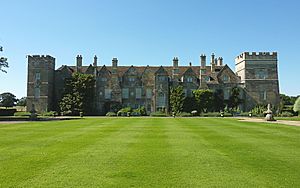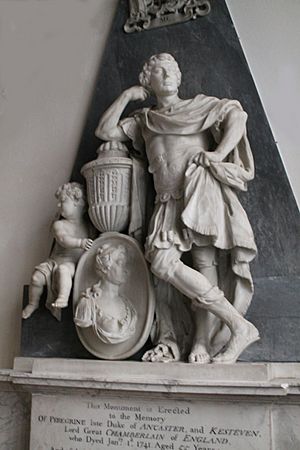Peregrine Bertie, 2nd Duke of Ancaster and Kesteven facts for kids

Peregrine Bertie, 2nd Duke of Ancaster and Kesteven (born April 29, 1686; died January 1, 1742) was an important British politician. He was known by several titles during his life. From 1686 to 1704, he was called The Honourable Peregrine Bertie. Later, he became Lord Willoughby de Eresby and then Marquess of Lindsey. He served in the House of Commons (a part of the British Parliament) from 1708 until 1715. After that, he moved to the House of Lords, another part of Parliament.
Contents
Peregrine Bertie's Early Years
Peregrine Bertie was the second son of Robert Bertie, who was the 1st Duke of Ancaster and Kesteven. His mother was Mary Wynn. Peregrine became the heir to his family's titles in 1704. This happened after his older brother passed away.
Peregrine's Political Journey
Peregrine Bertie started his political career in 1708. He was elected as a Member of Parliament (MP) for Lincolnshire. His father, who was a Whig, supported him. However, Peregrine often acted like a Tory. These were two main political groups at the time.
Serving in the House of Commons
As an MP, Peregrine worked on several important projects. He helped create laws for the church in Boston. He also looked into rules that prevented certain people from holding public jobs. He voted against the impeachment (a formal accusation) of Dr. Henry Sacheverell in 1710.
Peregrine was re-elected in 1710. He was seen as a "worthy patriot" for finding problems in the government. He also opposed the continuation of the War of the Spanish Succession. This was a major war happening at the time. He was part of a group called the October Club. He also helped draft bills for waterworks near Boston and for draining land. In 1714, he voted against expelling another politician, Richard Steele.
Moving to the House of Lords
Peregrine did not run for election in 1715. Instead, he was called to the House of Lords. This happened on March 16, 1715. He took on his father's title, Baron Willoughby de Eresby.
Important Roles and Family Life
In June 1711, Lord Willoughby married Jane Brownlow. She was the daughter of Sir John Brownlow. From 1719 to 1727, Peregrine was a Gentleman of the Bedchamber to King George I. This meant he had a special role assisting the King.
In 1723, Peregrine's father passed away. Peregrine then inherited the rest of his family's titles. He also became the hereditary Lord Great Chamberlain. This was a very important official role in the British government. He also inherited family homes like Grimsthorpe Castle and Eresby in Lincolnshire. He also owned Lindsey House in London.
In 1724, he became the Lord Lieutenant of Lincolnshire. This was another significant role, representing the King in the county. From 1728 until his death, he managed rents for the Duchy of Lancaster in Lincolnshire. He also served on the board of governors for the Foundling Hospital. This charity was founded in 1739 to care for abandoned children.
Peregrine's wife, Jane, died in 1736. Peregrine himself passed away on January 1, 1742. He had seven children. His children included Peregrine Bertie, who became the 3rd Duke, and Brownlow Bertie, who became the 5th Duke. His son, Lord Albemarle Bertie, was known as a gambler and sportsman.
Images for kids
-
George Knapton's Portrait of Jane Bertie, daughter of the 2nd Duke of Ancaster.



